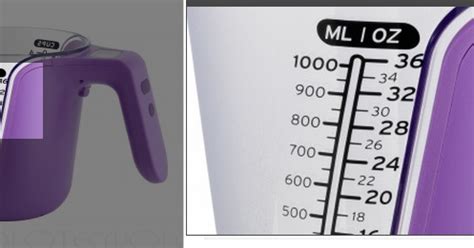Cuantas Onzas Es Un Litro De Agua
Kalali
Mar 31, 2025 · 4 min read

Table of Contents
- Cuantas Onzas Es Un Litro De Agua
- Table of Contents
- How Many Ounces Are in a Liter of Water? A Comprehensive Guide
- Understanding Units of Measurement: Liters and Ounces
- The Conversion: Liters to US Fluid Ounces
- Practical Applications and Scenarios
- Converting Larger or Smaller Volumes
- Beyond Water: Converting Other Liquids
- Common Mistakes to Avoid
- Conclusion
- Latest Posts
- Latest Posts
- Related Post
How Many Ounces Are in a Liter of Water? A Comprehensive Guide
The question, "How many ounces are in a liter of water?" might seem simple, but understanding the nuances behind the conversion requires a deeper dive into units of measurement and their practical applications. This comprehensive guide will not only answer this question definitively but also explore the related concepts, helping you confidently navigate liquid measurements in various contexts.
Understanding Units of Measurement: Liters and Ounces
Before delving into the conversion, let's clarify the units involved:
-
Liter (L): A metric unit of volume, commonly used for measuring liquids. It's a fundamental unit in the International System of Units (SI). A liter is defined as the volume occupied by one kilogram of pure water at its maximum density (approximately 4°C).
-
Ounce (oz): A unit of volume, primarily used in the imperial and US customary systems. There are two types of fluid ounces:
- US fluid ounce (fl oz): Used in the United States.
- Imperial fluid ounce (fl oz): Used in the United Kingdom and other Commonwealth countries. The imperial fluid ounce is slightly larger than the US fluid ounce.
The difference between US and Imperial fluid ounces is crucial for accurate conversions. Failing to specify which ounce you're using leads to significant errors in calculations. This guide will primarily focus on the US fluid ounce, as it's more prevalent in many parts of the world.
The Conversion: Liters to US Fluid Ounces
One liter is equivalent to approximately 33.814 US fluid ounces. This is a widely accepted conversion factor. Therefore, if you have 1 liter of water, you have approximately 33.814 US fluid ounces of water.
Important Note: This is an approximate conversion. The precise value depends on several factors, including temperature and pressure. However, for most practical purposes, 33.814 is sufficiently accurate.
Practical Applications and Scenarios
Understanding this conversion is vital in various situations:
-
Cooking and Baking: Many recipes, particularly those originating from the United States, use fluid ounces as a unit of measurement. If you're working with a recipe that calls for a specific amount in fluid ounces and you only have a liter-marked measuring device, this conversion is essential for accurate results.
-
Scientific Experiments: In scientific settings, precise measurements are crucial. Knowing the conversion factor allows for accurate transfer of liquid volumes between metric and imperial systems.
-
Medical Applications: Some medications or intravenous solutions may have dosage instructions given in fluid ounces. Converting liters to ounces is crucial for accurate administration.
-
Travel: When traveling internationally, you might encounter different measurement systems. Understanding this conversion allows you to easily compare volumes in different units.
Converting Larger or Smaller Volumes
The conversion factor (33.814 US fluid ounces per liter) can be easily applied to convert larger or smaller volumes:
-
Multiple Liters: To convert multiple liters to fluid ounces, simply multiply the number of liters by 33.814. For example, 2 liters would be 2 * 33.814 = 67.628 US fluid ounces.
-
Fractions of a Liter: To convert fractions of a liter, multiply the fraction by 33.814. For example, 0.5 liters (half a liter) would be 0.5 * 33.814 = 16.907 US fluid ounces.
Beyond Water: Converting Other Liquids
While this article focuses on water, the conversion factor remains approximately the same for most liquids. The slight variations occur because of the density differences between various liquids. However, for most everyday purposes, using 33.814 as the conversion factor provides sufficient accuracy for liquids with similar densities to water. For highly dense or less dense liquids, a more precise conversion may require considering the specific density of the liquid.
Common Mistakes to Avoid
-
Using the wrong type of ounce: Remember to distinguish between US and Imperial fluid ounces. Using the incorrect ounce will lead to significant errors.
-
Rounding Errors: While rounding is often necessary for practical applications, be mindful of the potential for accumulation of rounding errors when performing multiple conversions.
-
Ignoring Density Differences: While relatively small for many common liquids, remember that density differences can affect the precise conversion for liquids significantly different in density compared to water.
Conclusion
The conversion of liters to US fluid ounces, specifically for water, is a fundamental skill in various fields. Understanding this conversion—along with its practical applications and potential pitfalls—empowers you to confidently navigate liquid measurements and ensures accuracy in cooking, scientific experiments, medical applications, and everyday tasks. Remember the key conversion factor of approximately 33.814 US fluid ounces per liter, and always be mindful of potential sources of error to maintain accuracy.
Latest Posts
Latest Posts
-
How Many Cm In 2 Metres
Apr 03, 2025
-
Multiplication And Division Of Complex Numbers
Apr 03, 2025
-
What Is 1435 In Military Time
Apr 03, 2025
-
2 3 Cup Equals How Many Ounces
Apr 03, 2025
-
185 Cm In Inches And Feet
Apr 03, 2025
Related Post
Thank you for visiting our website which covers about Cuantas Onzas Es Un Litro De Agua . We hope the information provided has been useful to you. Feel free to contact us if you have any questions or need further assistance. See you next time and don't miss to bookmark.
